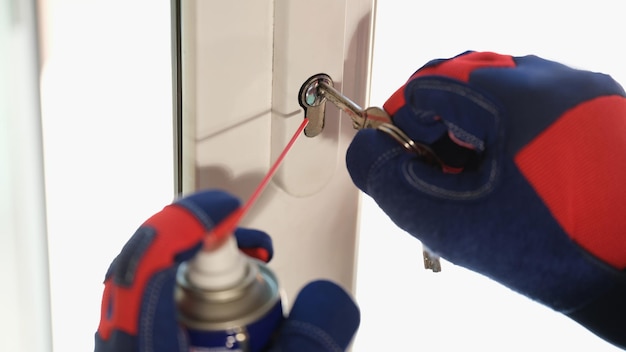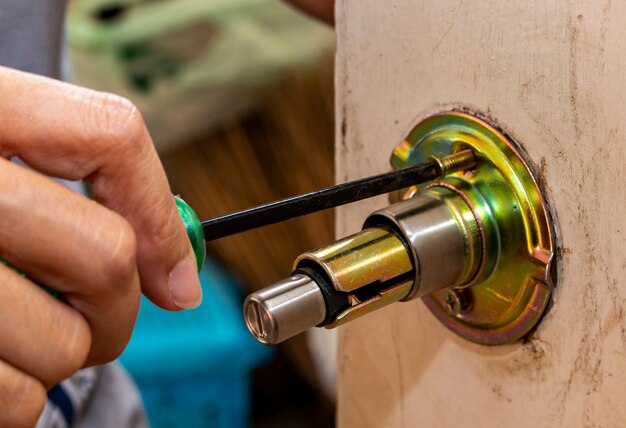
Your trusty lock effectively guards your home against intruders. This begs the question–what do you do when it starts malfunctioning? For example, when its components, like cylinder pins, need replacing?
In this piece, we’ll delve deep into the specifics of changing broken lock cylinder pins effectively.
We’ll also shed light on the lock’s vital components—cylinders and pins. The early warning signs of wear or damage to these essential parts will also be unveiled, as well as the perils of neglecting a malfunctioning lock.
Table of Contents
Understanding Lock Cylinders and Pins
Lock cylinders are the concealed engines of your lock, orchestrating the intricate dance of security. At the heart of this mechanism lies the essential players—pins.
These small but mighty components come in various types, each with its own specific role in the lock’s operation. It’s imperative to distinguish between them and comprehend how their harmonious interaction ensures your lock’s integrity.
When pins break or wear down, they disrupt this delicate balance, potentially leaving your security in peril.
To gauge the condition of your lock, perform a simple test. Insert your key gently and observe its movement. If it feels resistant, sticky, or uneven, it’s a telltale sign that the pins might be in need of attention.
Tools and Materials Needed
To embark on this endeavour, gather your toolkit. A trusty Phillips screwdriver and a flathead companion are your primary allies. Pliers will provide the necessary finesse, and don’t forget those replacement pins.
In the pursuit of high-quality replacement pins, pay attention to detail. The key to successful repairs is to match the size and type of pins precisely. Ensuring they align flawlessly with the cylinder is paramount.
Tweezers or needle-nose pliers are indispensable for this delicate task. As you proceed, testing the pin action is crucial. Insert the key with caution, feeling for smooth movement. Any signs of sticking or roughness should trigger caution, prompting a reassessment of your work. Patience is your ally in this intricate endeavour.
Lastly, maintain a workspace that gleams with organisation, where every tool has its place, and labelled containers safeguard the tiny components from confusion.
Removing the Lock Cylinder
The path to repairing a lock cylinder commences with removing it.
The process may vary depending on your lock type, so follow a specific guide tailored to your lock model. Be patient and gentle during this step to avoid damaging the lock or door components.
If you encounter rust or stubborn parts, applying a penetrating lubricant can make the process smoother. Remember, photographs documenting each stage will prove invaluable when it’s time to reassemble the puzzle.
Disassembling the Lock Cylinder
Disassembling the lock cylinder allows us to explore its innermost secrets. Your approach here must be methodical. Pay close attention to the order of removal; this will simplify the reassembly process.
To maintain order amidst the chaos of tiny components, consider using small plastic containers or an egg carton as makeshift organisers.
Cleaning each component meticulously with a suitable solvent is crucial. It’s during this stage that you’ll inspect for any signs of wear, damage, or irregularities, such as bent springs or worn pins.
Take your time during the cleaning and inspection phase. A thorough examination ensures that you catch any issues before reassembly.

Replacing the Broken Pins
Now comes the pivotal moment—replacing the broken pins. One essential tip is to choose replacement pins that match the size and type of the original pins precisely. When placing the new pins, take your time to align them correctly within the pin chambers.
If you encounter any resistance, it’s crucial to troubleshoot and ensure that each pin sits flush and moves smoothly, as this will determine the lock’s functionality.
Reassembling the Lock Cylinder
Reassembling the lock cylinder is like putting together a complex puzzle. Follow a step--step guide that corresponds to your lock model to ensure that each component is returned to its proper place.
A valuable tip here is to avoid rushing through this step and to double-check that everything fits snugly. Test the lock’s functionality before proceeding to installation to ensure a smooth key turn post-reassembly.
Reinstalling the Lock Cylinder
Reassembly is the final task, where all the components come together in perfect harmony. It’s imperative to follow the photographic or notational records meticulously to avoid missteps. Double-check the alignment of pins and the positioning of springs.
Before closing the curtain on this act, test the lock’s functionality without affixing the outer casing. This final check ensures that the internal components are working smoothly.
Exercise caution when reassembling the lock. Rushing this step can lead to costly mistakes.
Maintenance Tips for Lock Cylinders
With your lock restored, preserving its longevity becomes vital.
Create a schedule for regular lock maintenance, including cleaning and lubrication. Use a high-quality lock lubricant specifically designed for lock cylinders, applying it sparingly to prevent buildup.
Additionally, keep an eye out for signs such as key resistance or difficulty turning the lock, as these may indicate the need for professional maintenance.
Benefits of Using Professional Locksmith Services
While you now possess the skills to replace broken lock cylinder pins, there are scenarios where professional locksmith services offer distinct advantages. The expert assessment and repair of complex lock issues provide peace of mind.
Professionals have access to high-quality tools and replacement parts, ensuring the longevity of your lock’s performance. Consider seeking professional help when faced with intricate lock problems or when time and convenience are paramount.
Lock repair specialists can also assess your home and provide personalised tips on how to enhance your security. This can be invaluable in areas where burglaries are on the rise, so it’s an option not to be neglected.
Conclusion
In closing, the art of replacing broken lock cylinder pins is a skill that every homeowner should possess. Maintaining your lock from now on will be the cornerstone of home security.
Embrace DIY repairs with confidence while recognising when the time is right to seek professional assistance. With this newfound knowledge, you become the guardian of your home’s security, and the sanctity of your abode remains impenetrable.







